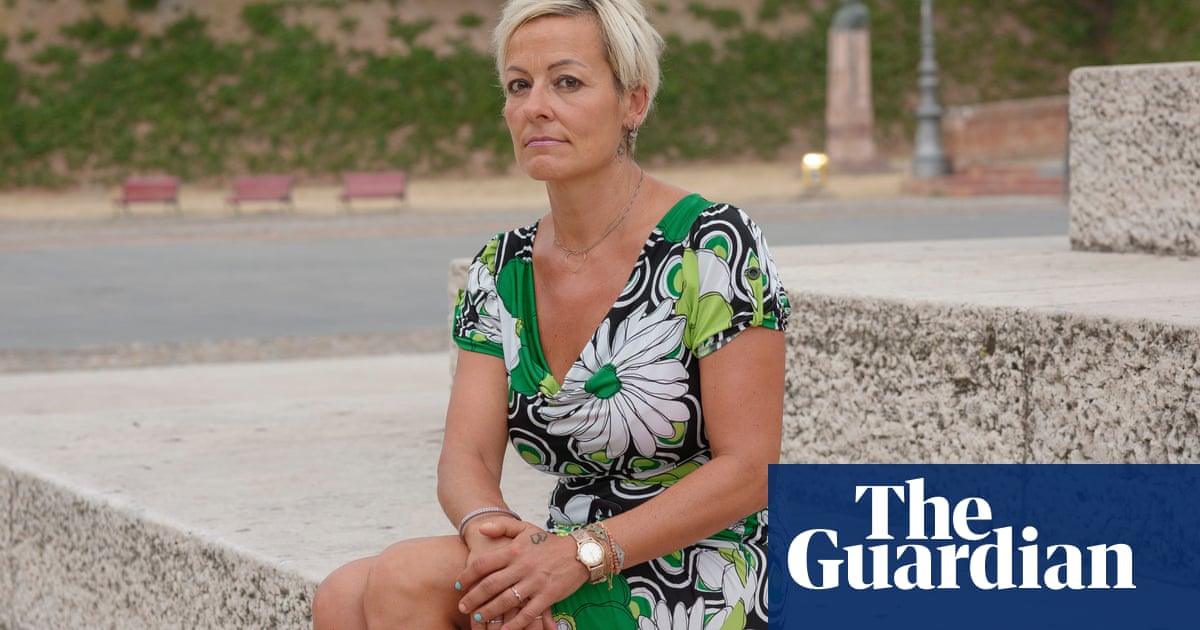‘It was a terrible sensation when I heard the sentence: life.” It was 11 March 2016 and Daniela Poggiali had just been confirmed as Italy’s “angel of death”. Less than 18 months after she had first been arrested, in October 2014, the nurse was now the country’s most infamous killer, convicted of killing one elderly patient and suspected of dozens of other murders.
“I struggled to rationalise it,” she says, “I just thought they were grabbing a crab.” (This is a curious Italian phrase that roughly translates as doing something irrational or idiotic.)
Today Poggiali looks exactly like she did when she first became national news. Her short blond hair frames a handsome face. She is wearing pale lipstick and short-shorts. She has a deep tan, a nose stud, various earrings and defiant tattoos (“Until the end” and “Nothing other than us”).
We’re meeting in the offices of Lorenzo Valgimigli, the lawyer she employed after that disastrous initial trial. Valgimigli’s offices are in Faenza, an ancient, brick-built town of about 60,000 inhabitants just south-east of Bologna. Poggiali has always lived here, or in the surrounding towns and villages.
She and Valgimigli endured nine years of trials and appeals in relation to two deaths. She was acquitted of murder in both cases on appeal, most recently in January 2023, but their version of what she has been through is alarming, and poses profound questions about cases involving suspected serial killers in healthcare.
Those are being posed with ever more urgency given the questions now surrounding the safety of Lucy Letby’s convictions. Letby is the nurse who was last year found guilty of the murder of seven newborns, and the attempted murder of seven others, in the neonatal unit of the Countess of Chester hospital, in the north-west of England. Criminal barristers, medics and statisticians have all expressed misgivings over the safety of her convictions.
Poggiali’s nine-year journey through the court system has been frequently referred to in discussions about Letby’s case. She was born on 23 October 1972, the youngest of three sisters. “Ours was a humble family,” she says. “My mother was a housewife and my father worked on the motorways.” She moved a few miles away to the city of Imola, studied accounting, and then changed tack and qualified as a nurse in 1995. “I was just curious to begin with,” she says, “but I slowly realised that I really liked it. I liked learning so many things, helping others, always being busy at work and being in contact with people.”
In 2012, Poggiali joined the staff of the palliative care department at Umberto I hospital in Lugo, near Ravenna. A childless and energetic 40-year-old, she took every shift offered. “Sometimes life was a bit too frenetic,” she says. “Work was busy and you would miss rest days. But otherwise I would just be an aunt or be with my mother. I liked to travel, listen to music, read books.”
Poggiali is an ebullient character and rubbed her colleagues up the wrong way. “I’ve never had filters in my personality,” she laughs. “I should bite my tongue, but I don’t. So I said things I shouldn’t have about my boss.” She made enemies among her peers, too. They believed she gave patients sleeping pills to have a quiet night shift, or laxatives to make sure her colleagues had a tough one. It was gossip that she has always denied. “In a workplace there’s always chitchat and jealousies,” she shakes her head, “but I never thought it could come to this.”
Her conduct was under scrutiny, however. Things went missing. Towards the end of 2013, there were 27 incidents of petty theft in the hospital. Her colleagues thought Poggiali was responsible and she was reported to the police. In 2014, she was given an obbligo di firma: an obligation to sign in daily at the local police station while awaiting trial for the thefts. She was found guilty in October 2016 of the attempted theft of the wallet of a man visiting his sick wife, and was sentenced to three months in custody and a €100 fine. In November 2016 she was also sentenced to four and a half years in custody for the theft of pharmaceuticals and food. Both sentences were upheld on appeal and in the supreme court.
Equally serious was her apparent celebration of death. Those who have worked in a hospice say that there is sometimes relief when a patient finally dies, relief that can come from a place of empathy or selfishness. In one moment of what she calls “stupidity”, Poggiali immortalised hers by giving a thumbs up next to an elderly patient who had just died. A colleague took a photo on her phone of Poggiali’s grinning face next to the open mouth of the deceased.
In spring 2014, her colleagues noted morti inattese (unexpected deaths) when Poggiali was on shift. Between 30 March and 6 April 2014, there were six. It was recorded on 2 April 2014 that potassium chloride had been incorrectly placed in the drawer of the nurses’ trolley (rather than in the dispensary) and that two phials of the medication – usually diluted and injected to treat or prevent low blood potassium – were unaccounted for. When another patient, 78-year-old Rosa Calderoni, died on 8 April 2014 (having been left alone with Poggiali), the hospital alerted the police, and the following day she was suspended.
Off work and still signing in at the police station every day because of the theft investigation, Poggiali tried to continue as normal. She had made plans to go to the Stuttgart beer festival in October. “I had even received permission from the authorities to travel abroad,” she says. “I had been round to say goodbye to my mum, and then, from a clear sky, the police turned up and invited me to the station. They said they had something to talk about.” The authorities had reversed their decision: she was no longer allowed to leave the country, and was being charged with murder over Calderoni’s death.
The following week, Italy’s “angel of death” was the lead story on the national news. Magistrates spoke of 38 morti sospette (suspicious deaths). The photograph of Poggiali’s pose over a corpse was blown up behind every newsreader.
Poggiali was imprisoned pending a trial, but her brief appearances in court had already made up many people’s minds: she seemed oddly carefree and smiling. “She never had a subservient attitude,” Valgimigli tells me. “She always had a straight back in court. It seemed like defiance.” In later years, she dyed her hair pink, wore cartoon-character T-shirts or pumped her fist. It was easy for the prosecutors and press to portray her as a gleeful she-devil.
The Poggiali case is intriguing given the debate about the safety of Lucy Letby’s convictions. Adam King, a practising barrister, has written in UnHerd that Letby’s case is an example of the “contagion of confirmation bias”, claiming the “theory” of her guilt “was based almost entirely on her having been on shift at the relevant times”. British justice has also been cross-examined in reporting by the New Yorker, the Guardian and the Financial Times. Private Eye’s MD column (authored by the physician Dr Phil Hammond) described at length the flaws in the prosecution’s case: postmortems found natural causes in the deaths of five of the seven babies. Many were extremely premature and profoundly fragile. Experts in the care of newborns told him there were more likely causes of death than the ones proposed by the prosecution, and that the main method of murder alleged – injecting air into the babies – was implausible.
The jury only heard about half the deaths during the period Letby was said to have been killing, making the data appear cherrypicked. The hospital unit was downgraded, meaning it no longer cared for the most premature and low-weight babies, around the same time that Letby was removed from duty. Comparing her shifts with those of later months was like comparing apples and pears.
The Guardian’s special correspondent, Felicity Lawrence, has reported on the letter submitted to the health secretary signed by 24 leading statisticians, paediatric doctors, forensic scientists and neonatologists. Speaking of “systemic issues” in justice regarding “medical serial killers”, it said: “We believe that legal systems are particularly vulnerable to errors when dealing with intricate scientific evidence, especially in cases involving statistical anomalies in healthcare settings.”
Those who doubt Letby’s convictions have pointed to various well-known miscarriages of justice. On first sight, the probabilities offered by prosecution experts in those cases seemed utterly convincing: in November 1999, solicitor Sally Clark was sentenced to life for the murder of her two infant sons following analysis that suggested the chances of two children in the same family suffering sudden infant death syndrome (or “cot death”) was “one in 73m”.
In 2003, Lucia de Berk, a Dutch paediatric nurse, was convicted of four murders and three attempted murders of children in her care (and, a year later, of seven murders and three attempted murders). One criminologist gave evidence to suggest that the probability of so many deaths occurring while De Berk was on duty was “one in 342m”. (Given these notorious examples of misleading probabilities, the prosecution in the Letby case avoided using “one in a million”-style claims.)
Clark’s and De Berk’s convictions were subsequently overturned, with professional statisticians pouring scorn on the analyses. In January 2002, the president of the Royal Statistical Society (RSS) wrote to the UK attorney general asserting that the “one in 73m figure cannot be regarded as statistically valid”, calling it “fallacious” and “a serious error of logic”. Clark was released a year later, but suffered from mental illness and alcoholism, and died in 2007. De Berk was exonerated in 2010.
The statistician who fought to clear De Berk’s name – Richard Gill, emeritus professor of mathematical statistics at Leiden University in the Netherlands – was also instrumental in overturning Daniela Poggiali’s conviction. Gill took to social media during the Lucy Letby trial to dispute the use of statistics in that case, and was warned by police that he was in danger of contempt of court. He says now that in each of these cases he sees “the same errors: bad data, incompetent statistical analysis”.
Along with Julia Mortera, a forensic statistician and now honorary professor at the University of Bristol, Gill was a co-author of an RSS paper published in September 2022, before Letby’s trial, entitled Healthcare Serial Killer Or Coincidence? Mortera was also an integral part of Poggiali’s defence team, and she and Gill co-authored, with another professor, Francesco Dotto, an academic paper about that case.
They assert that the murder convictions of medical staff are frequently based on the same errors. Confusion usually sets in with the foggy logic of the “Texas sharpshooter fallacy”, named after the apocryphal story of a gun-toting Texan who randomly fires off rounds into a barn door, finds a cluster and circles them as evidence that she’s a crack shot. In Gill and Mortera’s analysis, tunnel vision can quickly take over and all pieces of other evidence (the stray shots or outliers) are ignored. Stories and pictures emerge from our narrative impulses.
“At first, it’s just a load of dots,” the consultant on the ward where Lucy Letby worked told the author of the New Yorker essay, referring to the cluster connecting Letby’s presence when babies collapsed, “but you stare at them, and all of a sudden the picture appears. And then, once you can see that picture, you see it every time you look, and you think, ‘How the hell did I miss that?’”
When those clusters coincide with the presence of employees who are considered tricky or problematic, they appear more convincing, Gill says. He adds that prejudices often play a major role in giving significance to a cluster: “It’s about picking on a suitable scapegoat,” he tells me. “They have to be some kind of outsider.” This wasn’t true of Letby, who was said to be well liked, but Lucia de Berk was a former sex worker; and Sally Clark had been in the Priory clinic for postnatal depression. Other accused nurses have been neurodiverse, gay or foreign. “Daniela Poggiali was a nurse with a strong and colourful personality and a sharp tongue,” write Gill, Mortera and Dotto. Paradoxically, Gill notes that those accused are often the most conscientious, doing more shifts (which influences deaths-to-presence figures) or being vocally critical of failings in the hospital or their superiors.
Once a pattern of “suspicious” events has been identified, top hospital management or senior clinicians can appoint themselves investigators and interrogators, says Gill, “or to put it more crudely, carry out a witch-hunt”. In Poggiali’s case, a senior colleague became a de facto detective, recovering intravenous bags and testing for potassium. According to her lawyer, Valgimigli, gossip dominated the prosecution’s hypothesis: Poggiali had been heard to complain to colleagues that Rosa Calderoni was a difficult patient; another patient she was later accused of murdering was the former boss of her partner (a workman from the nearby town of Conselice), with whom she was thought to have had issues.
after newsletter promotion
Private notes or diaries provided “gotcha moments” in the cases against De Berk and Letby: De Berk writing about secret “compulsions” and Letby about being “evil” (“I am evil I did this”). Letby clearly felt bereft and guilty about repeated neonatal deaths on her watch. But feeling guilty, which innocent people often do, isn’t the same as being criminally responsible. It has recently been revealed that Letby’s notorious notes were actually the result of a cathartic exercise recommended by therapists.
The clincher against Poggiali was even worse: that photograph. It was used by the prosecution as the “homepage” of the courtroom screen, on show to the jury and press every day. “That photo was proof of my guilt,” she tells me with exasperation. “Having done something stupid doesn’t mean you’re a serial killer.” (Although now cleared of all murder charges, she has been struck off as a nurse owing to that unprofessional image.)
The other pillars of the prosecution in the cases of Poggiali and De Berk were the probabilities: what was the likelihood of it being just chance that they were always on duty when patients died? This is where statisticians are most sceptical of these murder convictions, since the interpretation of those duty rosters relies on which deaths they include. There are so many deaths at the extremity of life that it’s easy to cherrypick ones to show that X was “always” there.
This is the notorious “prosecutor’s fallacy”: in the words of the RSS paper, it leads people to confuse “the probability of the evidence given a hypothesis with the probability of the hypothesis given the evidence”. No one, the RSS paper urges, should think that the probability of an animal having four legs if it is a horse is the same as the probability that an animal is a horse if it has four legs. “The prosecutor’s fallacy,” the RSS report maintains, “is a seductive and widespread mode of reasoning, affecting the general public, the media, lawyers, jurors and judges alike.”
That fallacy underpins alleged cases of medical misconduct because someone testifies the probability of X number of deaths occurring randomly is, say, one in a million. On hearing that, people “transpose the conditional probabilities” and assume that there is a one in a million chance that the deaths are occurring randomly. It’s a bit like reasoning that since the chances of winning the lottery are one in 50m, anyone who does win is clearly a cheat: it’s so unlikely it must be fixed. It’s a short step from there to confuse the profound improbability of an event with the overwhelming probability of a suspect being guilty.
‘Prison is terrible,” recalls Poggiali. “Everything is uphill. Your family outside is doing badly because of you.” Her face suddenly gives way as she speaks. “Even now it moves me. You feel bad for your family.”
She was allowed eight 10-minute phone calls, and six physical visits a month. Most of her time was spent reading the novels of Christian Jacq, the French Egyptologist. She was on cleaning and cooking duties, and sometimes looked after the prison governor’s dog, Lillo. “I had the advantage of being in a small prison, a family setting. The staff were almost maternal figures. They seemed fond of me.”
She was the prison’s most infamous inmate, and during Sunday mass male prisoners from the adjacent facility would try to talk to her. She received “50 or so” letters a year, hoping for friendships or courtships. But former colleagues continued to shun her. “Before there were people who would smile, have a chat, a coffee. And then one said to me, ‘I’ve got to stay out of it because I’ve got two children I have to defend.’ What does that mean?”
For her lawyer, the use of gossip and hearsay showed how far her trial had strayed from a serious process. “Trials should reconstruct the evidence, giving a judgment that gets close to a science. If you graft on to that emotionality, irrationality, gut instincts and drives, you end up contaminating this reasoning.”
Valgimigli had been recommended to Poggiali after she was convicted of murder and sentenced to life in prison at the end of her first trial. He’s the archetypal provincial lawyer: an intellectual working out of an ancient palazzo with frescoed, vaulted ceilings. The sliding ladder behind his desk only reaches halfway up the shelves. He sourced experts who dismantled the postmortem potassium evidence. Potassium measurements from the vitreous humour of the eyeballs (where cell breakdown occurs more slowly) have long been one of a number of ways to estimate time of death (because the concentration of potassium increases more steadily there after death than in other organs). But the prosecution had used potassium levels to imply foul play. “A stroke of genius,” Valgimigli says sarcastically. “There is agreement [within the scientific community] that this model cannot be used to diagnose a fatal potassium infusion.”
Gill and Mortera’s submissions had been dismissed as irrelevant by a haughty judge in the first trial, but on appeal Valgimigli leaned heavily on their statistical expertise to distance causation from correlation. Mortera subsequently wrote of the prosecution’s statistics offered in Poggiali’s case as being “totally misleading”. “It’s a very serious mistake,” she tells me, “to assume that a significant association indicates a causation.”
A chart linking Poggiali’s shifts to deaths appeared, at first, a convincing graphic, a persuasive technique that has been used in many other trials of medical staff. But, as John O’Quigley of University College London pointed out in his recent paper on “statistical blunders”, all the shift chart shows is that “when the suspected nurse was on duty she was … on duty”.
There were many variables not accounted for in the statistical analysis presented by the prosecution in Poggiali’s case: all the other shifts she worked without deaths; the fact that deaths normally occur in early morning shifts, when Poggiali was invariably present; that admissions policies – accepting more acute cases, or fewer – affect a ward’s mortality rates.
In July 2017, Bologna’s court of appeal overturned Poggiali’s first-degree murder sentence and attributed Calderoni’s death to natural causes. After just over 1,000 days in custody, Poggiali emerged exultant.
Prosecutors appealed against the decision to the supreme court. They were clearly convinced of her guilt, but perhaps vanity played its part. Investigating magistrates in Italy become media stars, offering running commentaries on their investigations to TV cameras. It’s possible they didn’t want to lose not only a famous case, but also the national notoriety. (Those involved in the Letby investigation have also embraced the limelight, with police releasing an in-house documentary of their investigation and giving lengthy interviews to broadcasters.)
In 2018 the supreme court annulled the appeals court verdict and ordered a retrial. The following year Poggiali was again acquitted. In 2020, as she was nursing her dying mother, she was rearrested and charged with the murder of 95-year-old Massimo Montanari (her partner’s former employer, who had died on 12 March 2014, a month before Calderoni). On 15 December 2020 she was sentenced to life in prison. Again she was acquitted on appeal. She was also accused of having asked her sister over the phone to steal pharmaceuticals for their mother (that case was dismissed).
It was once hoped that statistics could blow away the mists of doubt in medical murder trials. But professional statisticians urge caution, not only about using them to determine innocence or guilt, but even to show that a murder has taken place. “We are talking about workplaces where many people do die,” says Gill. In premature baby and palliative care wards, death is a frequent occurrence, and determining the cause is notoriously imprecise.
Among their many recommendations in the RSS paper, Gill and Mortera offer an established and poetic corrective to “the prosecutor’s fallacy”: Bayes’ theorem. Thomas Bayes was an 18th-century Presbyterian minister who found a means to “invert” (rather than “transpose”) the conditional. Bayes’ theorem looks at the problem from the other end. If an animal has four legs, one can only calculate the probability of it being a horse if one has more information (how many non-horse animals also have four legs). One needs to take into account the “prior probabilities”, which in medical settings means thousands of patients seeing hundreds of medics with almost endless variables. Very quickly this far more nuanced probabilistic reasoning makes those outlandish “one in a million” claims seem redundant.
Poggiali’s lawyer, Valgimigli, is still scandalised that she faced such an inquisition based on erroneous science. But he’s equally shocked that no one has been courageous enough to take Poggiali’s side in public: “I think it’s very serious that, in a legal process without precedent, there isn’t a mayor, an authority or an intellectual who has said, ‘What’s happening to her could happen to any of you.’”
Valgimigli is affable company. He orders chilled red wine for lunch and says he could never live outside the slim, brick buildings of his home town of Faenza. He seems to understand his compatriots’ misguided fears: some of his fellow Faentini, he says, “have never emerged from this nightmare, that there was an angel of death walking the corridors injecting death instead of saving life”. But he’s adamant that the real danger is something less fantastical: a false accusation. “In Romagna, we think we’re something a bit apart,” he says, meaning the locals consider themselves more civilised. “But are we truly safe? What does your life become if you come under malign suspicion, if you’re in the crosshairs?” Just because Poggiali appeared “brazen”, her case became a “very provincial witch‑hunt”.
Her life has been, if not ruined, certainly profoundly interrupted. Her name is toxic to employers. “You’re labelled that way,” she laments, “even if you’ve won all these trials. You go out and people look at you from afar – they start talking to the person next to them.”
She’s always busy, but is technically unemployed. She hasn’t moved though. She’s still here, strutting the diagonals of Faenza’s colonnaded squares. She drives a dusty Fiat Panda with a pink furry frog on the back seat. As we sit in it, she says she’s not sure what to do next. “I’ve thought about going abroad, but I’m limited linguistically. And it’s hard to start over if you don’t have economic means.” She has at least reconciled with her former partner.
She misses her old work, but is worried about its feasibility as a profession now, implying that the risks are too great. “One can’t be a nurse today,” she says. Talking about Letby, Poggiali says: “I’m very sorry for her on a human level. That’s a case that is even more sad than mine because it involved newborns. I think she could be innocent because she’s been painted as a serial killer on the basis of what? That she was always present when babies died?
“People don’t accept death any more,” Poggiali continues. “It’s always difficult to make them [the bereaved] believe it. They say: ‘But I was here yesterday and she [the relative] was fine.’” She is indignant at her treatment by the press, the judiciary and her fellow citizens. “Journalists are bastards. Sorry.” She feels like a scapegoat for a failing healthcare system that was underfunded and understaffed.
In many ways, Poggiali has always made a rod for her own back. Her talk of the need to accept death could easily be misinterpreted as confirmation that there really was a killer doing the rounds. Of all the stories, that’s the version people naturally want to believe, because a guilty individual provides a reason, a clear explanation for a relative’s death. Alternative explanations – system failures, chance, natural causes – are so much more boring than the old story that it’s all the fault of a beguiling witch.









